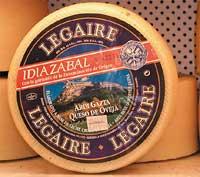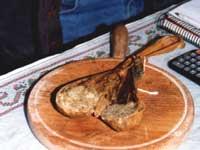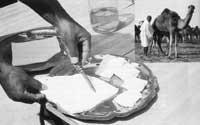Ancient cheese Idiazabal
2003/02/18 Andonegi Beristain, Garazi - Elhuyar Zientziaren Komunikazioa

To obtain the rennet, a lamb about a month is killed. The lamb dies when he just drinks milk and is removed from his fourth stomach, which is filled with milk. This stomach is dried, mixed with salt, and a paste is formed. The shepherds kept this pasta and when they were going to make the cheese, mixing it with water, the rennet was obtained. In the case of the commercial cuajo, the process of obtaining pasta is the same. From this mass, the rennet is also obtained through the filtration of water, which is subsequently sold in the form of liquid or dust. These liquids or powders, however, do not present the characteristics of the traditional rennet.
The shepherds suspected that with traditional rennet they obtained better cheeses. However, the traditional rennet had a problem: not always the same cheeses were obtained. The researchers of the UPV/EHU contacted seven years ago in order to know the causes of these changes.
The secret is in the lipases
The researchers first studied the traditional saleros of the shepherds. After analyzing the strength and composition of the coagulation of them, similar cuajas were produced in the laboratory. With these boxes, cheeses, and their taste, odors, etc. Once analyzed, its relationship with the pasta used was established. In these studies, the importance of lipase was discovered.

Lipase is a very special enzyme that when the lamb takes milk flows under the tongue. This enzyme, together with milk, reaches the stomach, which is the one used to make the garlic paste. The majority of the masses, therefore, contain lipases. But in the salineros that are sold in the form of liquid or dust the lipases are lost. Not only that, the traditional rennet used by the shepherds, the liquid, if preserved for a long time, also loses lipases, but not pastes. That is why different cheeses come out, since the number of lipases defines the strength of the cheese.
In view of this, the researchers want to control the quantity of cuajo lipases and have started to produce the traditional cuajo mass industrially. This paste will be marketed by a company vallisoletana that, in view of the interest and good behavior shown by the shepherds, hopes to recover the traditional product. In addition to Idiazabal cheese producers, other pastors from other communities have already shown their interest in trying this traditional dough.
www.basqueresearch.com/

Gai honi buruzko eduki gehiago
Elhuyarrek garatutako teknologia





